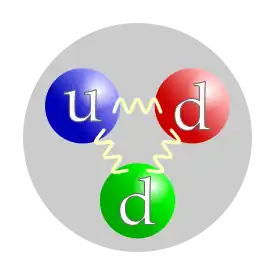| Science with neutrons |
|---|
 |
| Foundations |
| Neutron scattering |
| Other applications |
|
| Infrastructure |
|
| Neutron facilities |
Neutron backscattering is one of several inelastic neutron scattering techniques. Backscattering from monochromator and analyzer crystals is used to achieve an energy resolution in the order of μeV. Neutron backscattering experiments are performed to study atomic or molecular motion on a nanosecond time scale.
History
Neutron backscattering was proposed by Heinz Maier-Leibnitz in 1966,[1] and realized by some of his students in a test setup at the research reactor FRM I in Garching bei München, Germany.[2] Following this successful demonstration of principle, permanent spectrometers were built at Forschungszentrum Jülich and at the Institut Laue-Langevin (ILL). Later instruments brought an extension of the accessible momentum transfer range (IN13 at ILL), the introduction of focussing optics (IN16 at ILL), and a further increase of intensity by a compact design with a phase-space transform chopper (HFBS at NIST, SPHERES at FRM II, IN16B at the Institut Laue-Langevin).
Backscattering spectrometers
Operational backscattering spectrometers at reactors include IN10, IN13, and IN16B at the Institut Laue-Langevin, the High Flux Backscattering Spectrometer (HFBS) at the NIST Center for Neutron Research,[3] the SPHERES] instrument of Forschungszentrum Jülich at FRM II[4] and EMU at ANSTO.
Inverse geometry spectrometers
Inverse geometry spectrometers at spallation sources include IRIS and OSIRIS at the ISIS neutron source at Rutherford-Appleton, BASIS at the Spallation Neutron Source, and MARS at the Paul Scherrer Institute
Historic instruments
Historic instruments are the first backscattering spectrometer that was a temporary setup at FRM I and the backscattering spectrometer BSS (also called PI) at the DIDO reactor of the Forschungszentrum Jülich (decommissioned).[5]
References
- ↑ H. Maier-Leibnitz: Grundlagen für die Beurteilung von Intensitäts- und Genauigkeitsfragen bei Neutronenstreumessungen, Nukleonik 8, 61 (1966).
- ↑ Alefeld, B.; Birr, M.; Heidemann, A. (1969). "Ein neues hochauflösendes Neutronenkristallspektrometer und seine Anwendung". Die Naturwissenschaften. 56 (8): 410–412. Bibcode:1969NW.....56..410A. doi:10.1007/BF00593617. ISSN 0028-1042. S2CID 42571268.
- ↑ Meyer, A.; Dimeo, R. M.; Gehring, P. M.; Neumann, D. A. (2003). "The high-flux backscattering spectrometer at the NIST Center for Neutron Research". Review of Scientific Instruments. 74 (5): 2759. arXiv:cond-mat/0209153. Bibcode:2003RScI...74.2759M. doi:10.1063/1.1568557. ISSN 0034-6748. S2CID 56300356.
- ↑ Wuttke, Joachim; Budwig, Alfred; Drochner, Matthias; Kämmerling, Hans; Kayser, Franz-Joseph; Kleines, Harald; Ossovyi, Vladimir; Pardo, Luis Carlos; Prager, Michael; Richter, Dieter; Schneider, Gerald J.; Schneider, Harald; Staringer, Simon (2012). "SPHERES, Jülich's high-flux neutron backscattering spectrometer at FRM II". Review of Scientific Instruments. 83 (7): 075109. arXiv:1204.3415. Bibcode:2012RScI...83g5109W. doi:10.1063/1.4732806. ISSN 0034-6748. PMID 22852726. S2CID 3862676.
- ↑ A historical and updated review on neutron backscattering and its applications can be found on WEB-site of Neutron Backscattering Spectroscopy and a more recent version of it at http://www.astrosurf.com/heidemann/bsweb/index.htm/